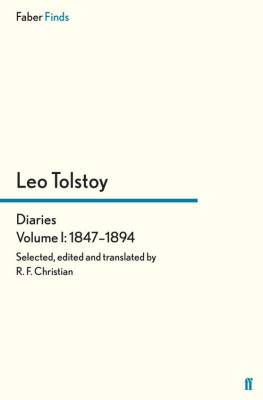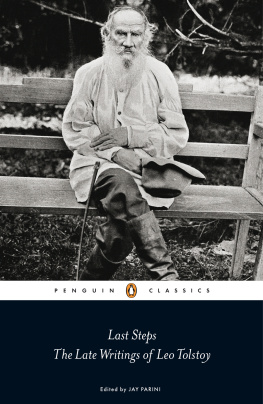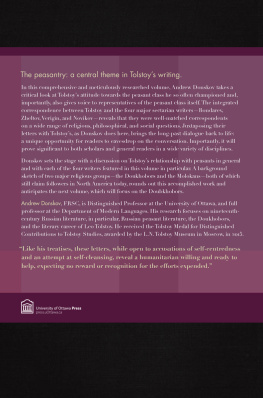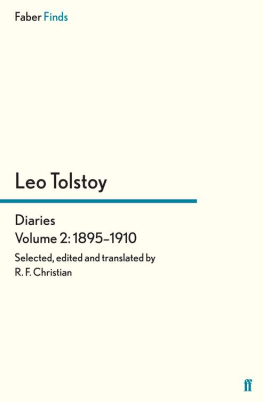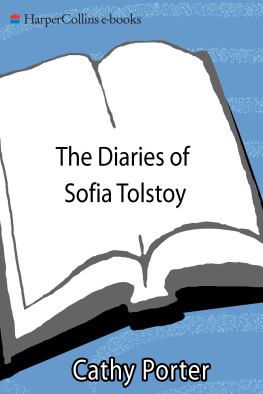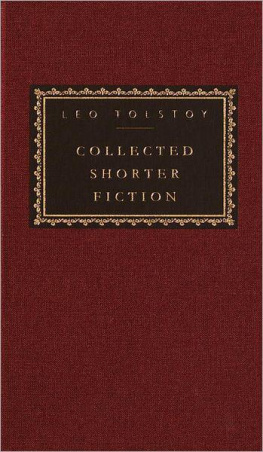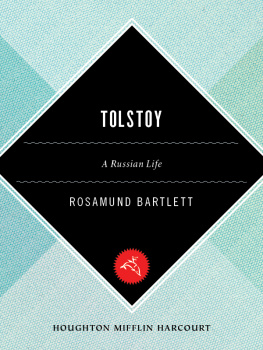Tolstoys literary activities famously began in the venereal diseases clinic of Kazan University in the spring of 1847, when he was eighteen years old. During the month that he spent in the clinic, in almost complete isolation, he started keeping a diary. To begin with, Tolstoy regarded his diary as a record of his hopelessly optimistic self-improvement programme. Later it became an outlet for his creative and philosophical reflections, and as such comprises an indispensable companion to his published writings, both fictional and otherwise.
Keeping a diary, for Tolstoy, was not the deeply private affair it is for most people, even if it started out that way. In the all-too-brief week between Tolstoys proposal and marriage to Sonya Behrs in September 1862, he felt it incumbent upon him to give his young fiance his diaries to read. The vivid realism which is the hallmark of Tolstoys fiction is matched by the frankness of his diary entries, but he did not feel he should conceal anything in his past from his future bride.
As an innocent and inexperienced eighteen-year-old girl, who had seen little of life, Sonya was deeply shocked and upset by what she later termed his excessive conscientiousness, particularly when it came to reading about his sexual history with peasant girls. Nevertheless, she went ahead with the marriage and before long she and her husband were regularly and sometimes frenetically reading each others diaries. It was a habit kept up until the very last months of Tolstoys long life in the summer and autumn of 1910, when his deteriorating relations with Sonya led him to try for the first time to keep a diary for himself alone.
Tolstoy did not keep a diary regularly throughout his life, for sometimes he transferred his exploration and articulation of psychological processes to his fictional works. Since his diaries span his entire adult life, however, they are indispensable reading for anyone seeking to look behind the scenes of the great novels and become better acquainted with their creator.
The same is true of Tolstoys letters, and his epistolary output was, as one might expect, equally prodigious there are 8,500 letters published in the Russian edition of his Complete Collected Works. Tolstoy wrote thousands of letters, to all manner of people, from persecuted peasant sectarians exiled to Siberia to the Romanovs, eventually addressing both muzhik and Tsar as Dear brother.
The most touching letters Tolstoy wrote were to his immediate family his wife Sonya, his children, his aunt and surrogate mother Tatyana Alexandrovna (Toinette), his sister and brothers. The most important letters he wrote were to his closest friends. First there was his distant relative Alexandra Andreyevna, a lady-in-waiting at Court, for whom he had the deepest respect and affection until his defection from the Orthodox Church. Then there was the shy and retiring Nikolay Strakhov, who worked at the Imperial Library in St Petersburg, but the most frequent recipient of Tolstoys letters was the aristocratic Vladimir Chertkov, his devoted follower. Chertkov was instrumental in disseminating Tolstoys religious ideas in translation, and thousands of people, from a dizzying array of faiths, felt compelled after reading them to write to the Sage of Yasnaya Polyana for his advice on how to live their lives. Tolstoy tried to reply to them all.
It will be a long time before we have full English editions of the fourteen volumes of Tolstoys diaries and the twenty-five volumes of his letters in the Complete Collected Works. In the meantime, we can be eternally grateful to R. F. Christian, doyen of Anglophone Tolstoy studies, for doing all the hard work for us. The result of Professor Christians scrupulous work is four manageable volumes containing faithful translations of the most important of Tolstoys diary entries and letters. Rendered into supple English, they are enhanced by judicious and helpful annotations, and introductions which draw on Professor Christians deep knowledge, the fruit of a distinguished career of studying and writing about Tolstoy. It is hard to see how these invaluable editions can be surpassed.
Rosamund Bartlett
Rosamund Bartlett is the author of Tolstoy: A Russian Life (Profile Books).
R. F. Christians four volumes of Tolstoys Diaries and Letters are all available in Faber Finds.
Tolstoys diaries greatly exceed in length and scope those of any other Russian author. They are usually divided into two categories. The diaries proper are written for the most part in exercise books, and are dated chronologically. The so-called notebooks consist of various kinds of scribbling pads, desk calendars and loose sheets of paper, some dated, some not. Some notebooks are virtually identical with diaries in the normal sense and contain entries, usually dated, for periods when Tolstoy did not keep a regular diary. Others contain random notes and observations, lists of popular expressions and a variety of ephemeral matter. Others again, especially those of the last twenty years of his life, were essentially first drafts of what were later to become entries in his diary proper. Tolstoys diaries and notebooks taken together occupy thirteen volumes of the ninety-volume Soviet edition of his works (the Jubilee Edition 192858), and it is most unlikely that they will ever be translated in full. For the purposes of this edition I have confined myself almost entirely to the diaries proper, and have only very occasionally included an extract from a noteboook or sheet of paper where the content seemed to justify it. When this has been done, I have indicated it in a footnote.
Tolstoys diaries span a period of sixty-three years. The first entry is dated 17 March 1847, when Tolstoy was aged eighteen and a student at Kazan University. The last entry was written on 3 November 1910, as he lay dying at the railway station at Astapovo. There are unfortunately considerable gaps in the record, of which the first is the three-year period from June 1847 to June 1850. It was once argued that Tolstoy had destroyed his diaries for these years, but there is no evidence to support this contention and it is no longer seriously maintained. For the period 1850 to 1865 Tolstoy kept his diary fairly regularly in the sense that there are at least some entries for every year, but those for the late 1850s and early 1860s are comparatively short. Then there is a gap of thirteen years from 1865 to 1878 when Tolstoy was wholly absorbed in writing WarandPeace and AnnaKarenina in some respects surrogate diaries while from 1878 to 1888 there are relatively few entries except for two sustained six-month periods in 1881 and 1884. From 1888 to 1910 Tolstoy kept his diary regularly and the older he grew the longer it became. Roughly speaking, one half of it covers the period up to 1894 when Tolstoy was already sixty-six, while the other half is devoted to the last sixteen years of his life when his greatest literary achievements were behind him and his writing became increasingly didactic and moralistic. I have deliberately included a higher proportion of what he wrote in his younger days, but even so the balance of any selection must inevitably be weighted towards the years of his decline as an artist and his rapidly growing reputation as a moral and spiritual guide.
To translate all Tolstoys diaries into English would be a daunting task, and it is not surprising that it has never been undertaken. A beginning was made in 1917 with The

